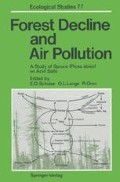Abstract
Understanding water relations is necessary to assess forest vigor, since numerous plant processes are influenced by the water status of the soil and the plant, e.g., growth, nutrient uptake, the production and release of growth substances and leaf gas exchange (Bradford and Hsiao 1982; Schulze 1986). However, the availability of water for sustaining these processes is not only dependent on control mechanisms at the individual plant level, but is also determined by the canopy structure and boundary conditions at the stand level (Jarvis and MacNaughton 1985; Jarvis 1987). The balance between rainfall and evapotranspiration at the stand level determines to a large extent the transport of substances into and out of the ecosystem. Water percolating through the soil profile carries nutrients which may be leached below the root zone into the groundwater (Ulrich 1987). The physical properties of the soil will in turn affect the availability of water and nutrients for plant uptake.
Access this chapter
Tax calculation will be finalised at checkout
Purchases are for personal use only
Preview
Unable to display preview. Download preview PDF.
References
Benecke P, Van Der Ploeg RR (1981) The soil environment. Encycl Plant Physiol NS vol 12A:539–560
Bradford KG, Hsiao TC (1982) Physiological responses to water stress. Physiological Plant Ecology II. In: Lange OL, Nobel PS, Osmond CB, Ziegler H (eds) Encyclopedia Plant Physiol. Springer, Berlin Heidelberg New York, NS vol 12B:263–324
Čermák J, Kučera J, Penka M (1976) Improvement of the method of sap flow rate determination in full-grown trees based on heat balance with direct electric heating of the xylem. Biol Plant 18:105–110
Hantschel R (1987) Wasser-und Elementbilanz von geschädigten, gedüngten Fichtenökosystemen im Fichtelgebirge unter Berücksichtigung von physikalischer und chemischer Bodenhete-rogenität. Bayreuther Bodenkd Ber 3: 1–219
Hantschel R, Durner W, Horn R (1987) Die Bedeutung von Porenheterogenität für die Erstellung der pF/WG-und K/psi-Kurven. Mitt Dtsch Bodenkd Ges 53:403–409
Haverkamp R, Vauclin M, Tourna J, Wierenga PJ, Vachaud G (1977) A comparison of numerical simulation models for one-dimensional infiltration. Soil Sci Soc J 41:285–294
Jarvis PG (1987) Water and carbon fluxes in ecosystems. In: Schulze ED, Zwölfer H (eds) Potentials and limitations of ecosystem analysis. Ecol Stud vol 61:50–67. Springer, Berlin Heidelberg New York Tokyo
Jarvis PG, McNaughton KG (1985) Stomatal control of transpiration: scaling up from leaf to region. Adv Ecol Res 15:1–49
Landsberg JJ (1986) Physiological ecology of forest production. Academic Press, Lond NY, 191 pp
Meyer J, Werk KS, Oren R, Zimmermann R, Schulze ED (1988) Performance of Picea abies (L.) Karst. at different stages of decline V. Root tips and ectomycorrhiza development and their relations to above ground and soil nutrients. Oecologia 77:7–13
Osonubi R, Oren R, Werk KS, Schulze ED (1988) Performance of Picea abies (L.) Karst. stands at different stages of decline. IV. Xylem sap concentrations of magnesium, calcium, potassium, and nitrogen. Oecologia 77:1–6
Running S (1984) Microclimate control of forest productivity: analysis by computer simulation of annual photosynthesis/transpiration balance in different environments. Agric For Meteorol 32:2–22
Schulze ED (1986) Carbon dioxide and water exchange in response to drought in the atmosphere and in the soil. Annu Rev Plant Physiol 37:247–274
Schulze ED, Čermák J, Matyssek R, Penka M, Zimmermann R, Vasicek F, Gries W, Kučera J (1985) Canopy transpiration and water fluxes in the xylem of the trunk of Larix and Picea trees — a comparison of xylem flow, porometer and cuvette measurements. Oecologia 66:475–483
Ulrich B (1987) Stability, elasticity, and resiliance of terrestrial ecosystems with respect to matter balance. In: Schulze ED, Zwölfer H (eds) Potentials and limitations of ecosystem analysis. Ecol Stud 61:11–49, Springer, Berlin Heidelberg New York Tokyo
Werk KS, Oren R, Schulze ED, Zimmermann R, Meyer J (1988) Performance of Picea abies (L.) Karst. stands at different stages of decline. III. Canopy transpiration of green trees. Oecologia 76:519–524
Editor information
Editors and Affiliations
Rights and permissions
Copyright information
© 1989 Springer-Verlag Berlin Heidelberg
About this paper
Cite this paper
Schulze, ED., Hantschel, R., Werk, K.S., Horn, R. (1989). Water Relations of Two Norway Spruce Stands at Different Stages of Decline. In: Schulze, ED., Lange, O.L., Oren, R. (eds) Forest Decline and Air Pollution. Ecological Studies, vol 77. Springer, Berlin, Heidelberg. https://doi.org/10.1007/978-3-642-61332-6_15
Download citation
DOI: https://doi.org/10.1007/978-3-642-61332-6_15
Publisher Name: Springer, Berlin, Heidelberg
Print ISBN: 978-3-642-64795-6
Online ISBN: 978-3-642-61332-6
eBook Packages: Springer Book Archive

